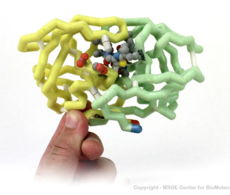Immunodeficiency virus protease
From Proteopedia
(Difference between revisions)
| Line 9: | Line 9: | ||
==Structure of HIV-1 Protease== | ==Structure of HIV-1 Protease== | ||
| - | The X-ray structure of HIV-1 protease<ref>PMID:2548279</ref><ref>PMID:2682266</ref> reveals that it is composed of <scene name='User:David_Canner/Sandbox_HIV/Identical_subunits/1'>two symmetrically related subunits</scene>, each consisting of 99 amino acid residues. The subunits come together in such as way as to <scene name='User:David_Canner/Sandbox_HIV/Tunnel/1'>form a tunnel where they meet</scene>. This tunnel is of critical importance because the active site of the protease is located in its interior. The active site consists of <scene name='User:David_Canner/Sandbox_HIV/Catalytic_triad/3'> two Asp-Thr-Gly conserved sequences</scene>, making it a member of the aspartyl protease family. The two Asp's are <scene name='User:David_Canner/Sandbox_HIV/Catalytic_asp/1'>essential catalytic residues</scene> either interact with the incoming water OR protonate the carbonyl to make the carbon more electrophilic for the incoming <scene name='31/315240/Saquinavir_cat_water/2'>water</scene>. You may be wondering how a polyprotein makes its way into the active-site tunnel, as the<scene name='User:David_Canner/Sandbox_HIV/Narrow_tunnel/1'> tunnel appears to be too narrow </scene> to admit it. The key is the two flexible flaps on the top of the tunnel that <scene name='User:David_Canner/Sandbox_HIV/Hiv_tunnel_morph/3'>move to allow proteins </scene>to enter the tunnel. The flaps <scene name='User:David_Canner/Sandbox_HIV/Hiv_tunnel_morph_flaps/2'>undergo a dramatic movement</scene>, shifting from an open to a closed conformation to bind the target in an appropriate conformation for cleavage. | + | The X-ray structure of HIV-1 protease<ref>PMID:2548279</ref><ref>PMID:2682266</ref> reveals that it is composed of <scene name='User:David_Canner/Sandbox_HIV/Identical_subunits/1'>two symmetrically related subunits</scene>, each consisting of 99 amino acid residues. The subunits come together in such as way as to <scene name='User:David_Canner/Sandbox_HIV/Tunnel/1'>form a tunnel where they meet</scene>. This tunnel is of critical importance because the active site of the protease is located in its interior. The active site consists of <scene name='User:David_Canner/Sandbox_HIV/Catalytic_triad/3'> two Asp-Thr-Gly conserved sequences</scene>, making it a member of the aspartyl protease family. The two Asp's are <scene name='User:David_Canner/Sandbox_HIV/Catalytic_asp/1'>essential catalytic residues</scene> either interact with the incoming water OR protonate the carbonyl to make the carbon more electrophilic for the incoming <scene name='31/315240/Saquinavir_cat_water/2'>water</scene>. You may be wondering how a polyprotein makes its way into the active-site tunnel, as the<scene name='User:David_Canner/Sandbox_HIV/Narrow_tunnel/1'> tunnel appears to be too narrow </scene> to admit it. The key is the two flexible flaps on the top of the tunnel that <scene name='User:David_Canner/Sandbox_HIV/Hiv_tunnel_morph/3'>move to allow proteins </scene>to enter the tunnel. The flaps <scene name='User:David_Canner/Sandbox_HIV/Hiv_tunnel_morph_flaps/2'>undergo a dramatic movement</scene>, shifting from an open to a closed conformation to bind the target in an appropriate conformation for cleavage. This is more clearly seen at [[Flaps Morph for HIV Protease]]. |
==Medical Implications== | ==Medical Implications== | ||
| Line 38: | Line 38: | ||
==Additional resources== | ==Additional resources== | ||
*''Aids Before Protease Inhibitors'' and ''HIV Protease Inhibitors: A Breakthrough'' at [[Molecular Playground/HIV Protease Inhibitor|HIV Protease Inhibitor]]. | *''Aids Before Protease Inhibitors'' and ''HIV Protease Inhibitors: A Breakthrough'' at [[Molecular Playground/HIV Protease Inhibitor|HIV Protease Inhibitor]]. | ||
| + | *[[Flaps Morph for HIV Protease]] | ||
*[[HIV Protease Inhibitor Pharmacokinetics]] | *[[HIV Protease Inhibitor Pharmacokinetics]] | ||
*[[Treatments:HIV Protease Inhibitor Pharmacokinetics References]] | *[[Treatments:HIV Protease Inhibitor Pharmacokinetics References]] | ||
Revision as of 20:35, 23 February 2020
| |||||||||||
Proteopedia Page Contributors and Editors (what is this?)
Joel L. Sussman, Michal Harel, Eran Hodis, Mark Hoelzer, Marius Mihasan, David Canner, Eric Martz, Ann Taylor, Wayne Decatur, Alexander Berchansky, Jaime Prilusky, Karsten Theis



